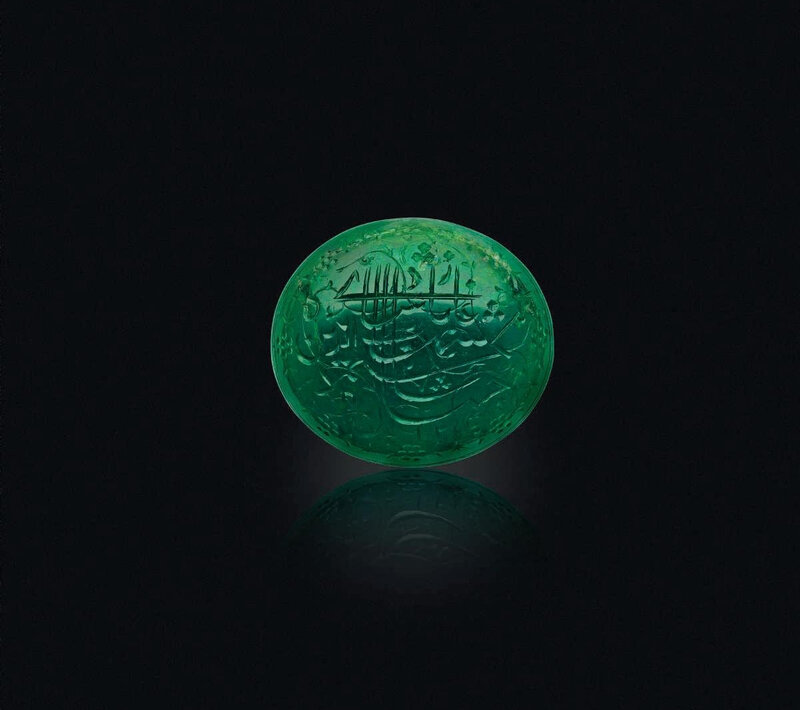Christie's. Maharajas & Mughal Magnificence, New York, 19 June 2019
The Shah Jahan Emerald. A carved emerald
Lot 340. The Shah Jahan Emerald. A carved oval cabochon Colombian emerald of 30.60 carats, 24.90 x 21.98 x 7.41 mm, circa 1621-1622. Estimate USD 500,000 - USD 700,000. Price realised USD 555,000. © Christie's Image Ltd 2019.
AGL, 2019, report no. 1100307: 30.60 carats, Colombia, minor clarity enhancement, modern type.
Literature: Jaffer 2013, p. 95, no. 11.
Exhibited: The Miho Museum, Koka 2016, p. 77, no. 48
Grand Palais, Paris 2017, p. 42, no. 13
The Doge’s Palace, Venice 2017, p. 55, no. 8
The Palace Museum, Beijing 2018, p. 66, no. 9
de Young Legion of Honor, San Francisco 2018, p. 53, no. 5.
Note: Mughal emeralds typically include spiritual texts when bearing an inscription. This rare emerald is inscribed with the name of Shah Jahan, but is dated prior to his accession to the throne in 1628. The inscription indicates that the emerald was likely inscribed during the time period when Shah Jahan unsuccessfully rebelled against his father, Jahangir.
Considered one of the most consequential Mughal rulers, Shah Jahan reigned during what is now termed the Golden Age of the Mughal Empire. He ascended the throne in 1627 after the death of his father, Emperor Jahangir. The third of five sons, Shah Jahan was granted the title “Shah Jahan” by his father. Translating to “King of the World,” it is by this name that he is known and not his given name. His thirty-year rule, 1628-1658, saw the development of the most significant examples of Mughal architecture and design.
An increasingly ambitious leader, Shah Jahan was responsible for the expansion of the territory under Mughal rule, as well as the construction of the most significant examples of Mughal architecture and design in history. Shah Jahan’s vision for expansion was a holistic approach, using military prowess to extend his empire and propagating design and art to further unify his subjects.
The Taj Mahal, in its scale and scope, is Shah Jahan’s best known symbol of his commitment to high Mughal architecture. The mausoleum was built on the bank of the Yamuna River in Agra as a tribute to his wife, Arjumand Banu Begum, known as Mumtaz Mahal, following her death during childbirth.
During his rule, Shah Jahan commissioned several architectural masterpieces, including the Moti Masjid, the Agra Fort, the Red Fort and the Wazir Khan Mosque. It is his throne, however, that provides the clearest evidence of his taste and standard for high art and design. Shah Jahan commissioned a solid gold throne with enamel, pearl and precious stones as a replacement for his father’s throne. His father’s throne, the throne of Jahangir, was a rectangular platform of engraved black basalt. In stark contrast, Shah Jahan’s elaborate throne was considered one of the primary examples of Golden Age Mughal design and cost twice as much to produce as the Taj Mahal. This throne was used by subsequent Mughal emperors following Shah Jahan’s death and ultimately pilfered from the city by invading Persians in 1739.
Shah Jahan was deposed from the throne in 1658 by his son, Aurangzeb. It is likely Shah Jahan’s ambition led to his ultimate removal from the throne: his expanding empire spread the military too thin, allowing opportunity for rival ruling factions to challenge control; military losses begat financial instability, which was complicated further when coupled with his custom for his lavish spending. Shah Jahan fell ill and his sons sensed an opportunity to seize control. Aurangzeb emerged victorious and Shah Jahan was placed under house arrest at Agra Fort until his death in 1666.
Shah Jahan died in 1666 and was buried next to his wife in the Taj Mahal. It is believed that he had intended to build a second mausoleum for himself: a Taj Mahal in black marble across the Yamuna river from his wife’s. His removal from power ensured that this project would never be seen to fruition. His cenotaph, instead, was inserted beside Mumtaz Mahal and they were oriented north to south in compliance with Islamic practice. Her cenotaph is in the center with his on the west side of the enclosure to her right. This asymmetry suggests that Shah Jahan never intended to be buried there.

/https%3A%2F%2Fprofilepics.canalblog.com%2Fprofilepics%2F1%2F0%2F100183.jpg)
/https%3A%2F%2Fstorage.canalblog.com%2F03%2F02%2F119589%2F96711876_o.jpg)
/https%3A%2F%2Fstorage.canalblog.com%2F11%2F31%2F119589%2F94773502_o.jpg)
/https%3A%2F%2Fstorage.canalblog.com%2F20%2F83%2F119589%2F94772815_o.jpg)
/https%3A%2F%2Fstorage.canalblog.com%2F26%2F72%2F119589%2F75604929_o.jpg)
/https%3A%2F%2Fstorage.canalblog.com%2F59%2F60%2F119589%2F26458628_o.jpg)



/http%3A%2F%2Fstorage.canalblog.com%2F03%2F39%2F119589%2F93594516_o.jpg)
/image%2F1371349%2F20240426%2Fob_9bd94f_440340918-1658263111610368-58180761217.jpg)
/image%2F1371349%2F20240426%2Fob_cfa6e3_440317478-1658265314943481-25907527200.jpg)
/image%2F1371349%2F20240426%2Fob_844371_440162278-1658267648276581-39734064969.jpg)